英语阅读课教学设计
2024年英语阅读课教学设计全英教案
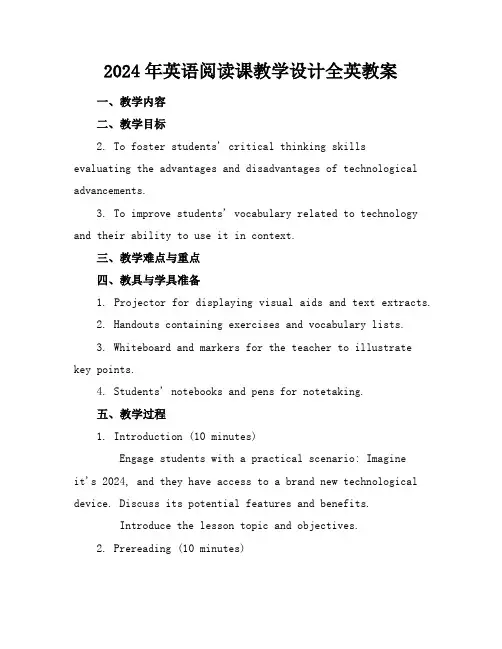
2024年英语阅读课教学设计全英教案一、教学内容二、教学目标2. To foster students' critical thinking skills evaluating the advantages and disadvantages of technological advancements.3. To improve students' vocabulary related to technology and their ability to use it in context.三、教学难点与重点四、教具与学具准备1. Projector for displaying visual aids and text extracts.2. Handouts containing exercises and vocabulary lists.3. Whiteboard and markers for the teacher to illustrate key points.4. Students' notebooks and pens for notetaking.五、教学过程1. Introduction (10 minutes)Engage students with a practical scenario: Imagineit's 2024, and they have access to a brand new technological device. Discuss its potential features and benefits.Introduce the lesson topic and objectives.2. Prereading (10 minutes)Display a mindmap of technologyrelated vocabulary on the board.3. Whilereading (40 minutes)Teacher guides the class through a detailed analysis of the text structure, highlighting main ideas, supporting details, and future tense usage.Conduct group discussions on specific extracts to encourage critical thinking.4. Postreading (20 minutes)六、板书设计The board will be divided into sections for vocabulary, main ideas, and questions for critical thinking. Keywords and important phrases will be underlined and highlighted for easy reference.七、作业设计1. Write a short paragraph describing a future technological innovation and its potential impact on society.Answer: (Sample answer provided: A future technological innovation I envision is the development of autonomous flying cars. These cars could revolutionize transportation, reducing traffic congestion and accidents, while also decreasing the need for fuel and harmful emissions.)2. Answer the following questions based on the text:a. What are the main technological advancements predicted for 2024?b. How do these advancements differ from presentday technology?c. Discuss the potential positive and negative consequences of these innovations.八、课后反思及拓展延伸1. Reflection: Assess the effectiveness of the teaching methods, students' engagement, and their understanding of the text.2. Extension: Encourage students to research a current technological innovation and present a brief report on its potential future development and implications for society.重点和难点解析1. 教学难点与重点的识别。
英语阅读课教学设计的八个环节
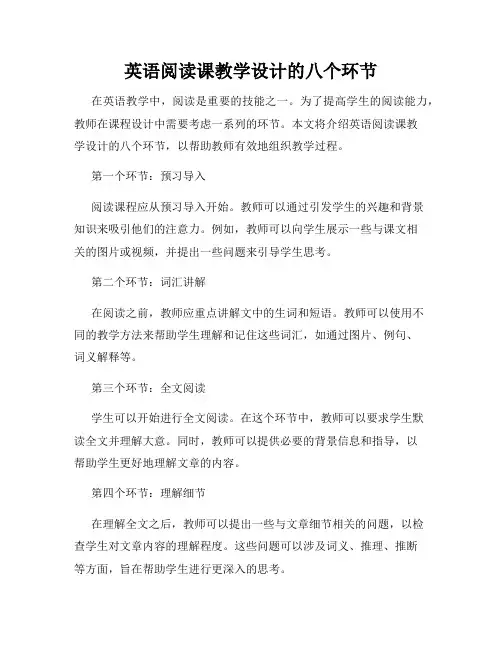
英语阅读课教学设计的八个环节在英语教学中,阅读是重要的技能之一。
为了提高学生的阅读能力,教师在课程设计中需要考虑一系列的环节。
本文将介绍英语阅读课教学设计的八个环节,以帮助教师有效地组织教学过程。
第一个环节:预习导入阅读课程应从预习导入开始。
教师可以通过引发学生的兴趣和背景知识来吸引他们的注意力。
例如,教师可以向学生展示一些与课文相关的图片或视频,并提出一些问题来引导学生思考。
第二个环节:词汇讲解在阅读之前,教师应重点讲解文中的生词和短语。
教师可以使用不同的教学方法来帮助学生理解和记住这些词汇,如通过图片、例句、词义解释等。
第三个环节:全文阅读学生可以开始进行全文阅读。
在这个环节中,教师可以要求学生默读全文并理解大意。
同时,教师可以提供必要的背景信息和指导,以帮助学生更好地理解文章的内容。
第四个环节:理解细节在理解全文之后,教师可以提出一些与文章细节相关的问题,以检查学生对文章内容的理解程度。
这些问题可以涉及词义、推理、推断等方面,旨在帮助学生进行更深入的思考。
第五个环节:交流讨论在这个环节中,教师可以组织学生之间的小组或全班讨论。
学生可以分享他们对文章的理解和个人意见,同时也可以借助同学们的见解来进一步拓展他们的思维。
第六个环节:语法和语言点讲解阅读课程不仅考察学生对文章内容的理解,还可以帮助学生学习和运用英语语法和语言点。
在这个环节中,教师可以针对文章中出现的语法和语言点进行讲解和练习,以加强学生的语言能力。
第七个环节:阅读技巧指导为了帮助学生提高阅读能力,教师可以向学生介绍一些阅读技巧和策略。
教师可以解释如何使用标题、段落标记、图片等元素来理解文章,以及如何运用猜词、推理和推断技巧解决阅读中的问题。
第八个环节:拓展阅读为了培养学生的阅读兴趣和拓展他们的知识面,教师可以引导学生进行拓展阅读。
例如,教师可以推荐一些与文章主题相关的书籍,让学生自主选择阅读并分享他们的观点。
总结:英语阅读课教学设计应包含预习导入、词汇讲解、全文阅读、理解细节、交流讨论、语法和语言点讲解、阅读技巧指导以及拓展阅读等八个环节。
英语阅读课教学设计全英教案
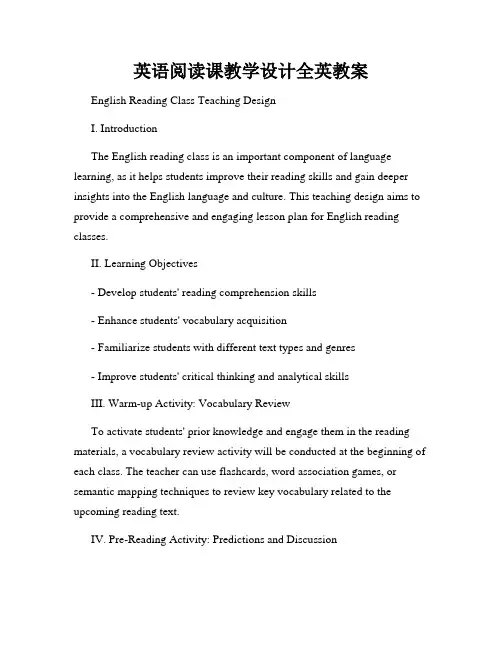
英语阅读课教学设计全英教案English Reading Class Teaching DesignI. IntroductionThe English reading class is an important component of language learning, as it helps students improve their reading skills and gain deeper insights into the English language and culture. This teaching design aims to provide a comprehensive and engaging lesson plan for English reading classes.II. Learning Objectives- Develop students' reading comprehension skills- Enhance students' vocabulary acquisition- Familiarize students with different text types and genres- Improve students' critical thinking and analytical skillsIII. Warm-up Activity: Vocabulary ReviewTo activate students' prior knowledge and engage them in the reading materials, a vocabulary review activity will be conducted at the beginning of each class. The teacher can use flashcards, word association games, or semantic mapping techniques to review key vocabulary related to the upcoming reading text.IV. Pre-Reading Activity: Predictions and DiscussionBefore diving into the main reading passage, students will be encouraged to make predictions based on the title, headlines, or visuals connected to the text. This pre-reading activity stimulates students' curiosity and prepares them for the upcoming reading tasks. Additionally, a short group or class discussion can be facilitated to activate students' background knowledge related to the topic.V. Reading Tasks1. Skimming: Students will read the text quickly to get a general understanding of the content. They will focus on identifying the main ideas, important dates, or key pieces of information within a given time limit.2. Scanning: Students will be given specific questions or statements to locate and retrieve information from the text. This activity aims to develop students' scanning skills, allowing them to find specific details efficiently.3. Detailed Reading: Students will read the text carefully and analyze the structure, style, and language used. They will answer comprehension questions, summarize paragraphs, or identify literary devices. This task promotes critical thinking and trains students to extract meaning from the text.4. Vocabulary Expansion: Throughout the reading process, students will encounter new words or expressions. In this phase, students will be guidedto infer word meanings from context, create personal vocabulary lists, and engage in vocabulary-related exercises such as word collocations, synonyms, or antonyms.VI. Post-Reading Activities1. Discussion and Reflection: After completing the main reading tasks, students will participate in a group or class discussion to share their opinions, thoughts, and reflections on the text. This activity encourages students to express themselves in English and develop their speaking and listening skills.2. Extension Activities: To further explore the text and expand students' comprehension, extension activities can be conducted, such as role-plays, debates, or creative writing tasks. These activities provide opportunities for students to apply the knowledge gained from the reading text in a practical and meaningful manner.VII. AssessmentTo evaluate students' progress and understanding, formative and summative assessments will be implemented. Formative assessments include classroom participation, group activities, and quizzes. Summative assessments may consist of reading comprehension tests, written assignments, or presentations based on the reading texts.VIII. ConclusionThis English reading class teaching design provides a systematic and engaging approach to developing students' reading skills. By incorporating various reading tasks, vocabulary expansion activities, and post-reading discussions, students will not only improve their reading comprehension but also enhance their critical thinking, analytical abilities, and overall language proficiency. This teaching design aims to create an immersive and dynamic learning environment that fosters a genuine love and appreciation for English literature and reading materials.。
英语阅读课教学设计
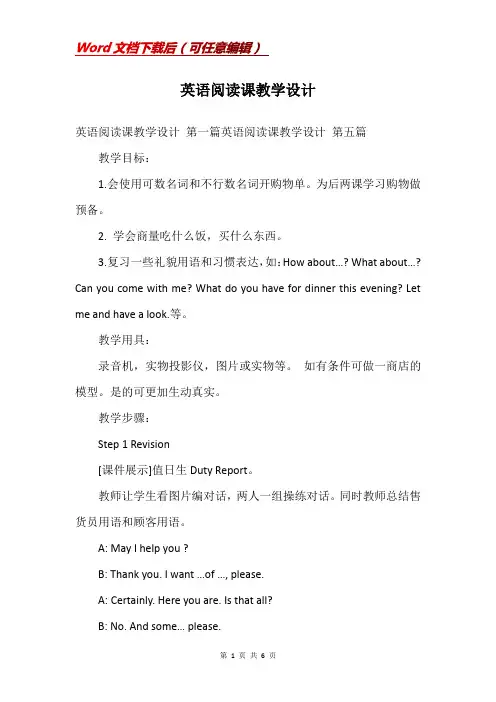
英语阅读课教学设计英语阅读课教学设计第一篇英语阅读课教学设计第五篇教学目标:1.会使用可数名词和不行数名词开购物单。
为后两课学习购物做预备。
2. 学会商量吃什么饭,买什么东西。
3.复习一些礼貌用语和习惯表达,如:How about…? What about…? Can you come with me? What do you have for dinner this evening? Let me and have a look.等。
教学用具:录音机,实物投影仪,图片或实物等。
如有条件可做一商店的模型。
是的可更加生动真实。
教学步骤:Step 1 Revision[课件展示]值日生Duty Report。
教师让学生看图片编对话,两人一组操练对话。
同时教师总结售货员用语和顾客用语。
A: May I help you ?B: Thank you. I want …of …, please.A: Certainly. Here you are. Is that all?B: No. And some… please.A: How many do you want?B: About…, please.Step 2 Read and act[课件展示]教师可以点击图片播放影片让学生观看。
教师点击图标播放录音并让学生跟读。
让学生听录音一遍后问:Where are they?在听录音一遍后问学生: What does Tom want to buy? What else? How many? How much are they?听第三遍,模仿跟读,直至练熟。
Step 4 practice[课件展示]教师点击图片播放影片让学生观看,使学生模仿情景影片中的对话,学生可依据课件中提供的食品名称和重量,两人一组自行编对话。
有条件的班级可以让学生进行对话演练。
Step 5 Listen and answer[课件展示]教师点击图标播放录音,同时让学生观看课件中的问题,要求学生边听边记。
(英语教案)优秀初中英语阅读课教案
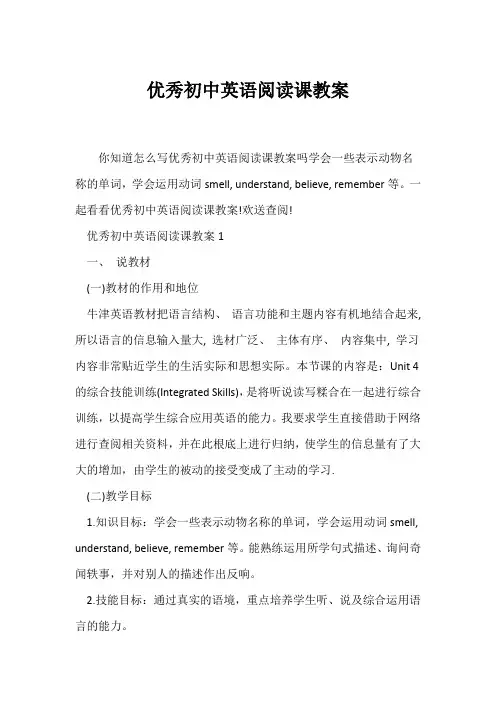
优秀初中英语阅读课教案你知道怎么写优秀初中英语阅读课教案吗学会一些表示动物名称的单词,学会运用动词smell, understand, believe, remember等。
一起看看优秀初中英语阅读课教案!欢送查阅!优秀初中英语阅读课教案1一、说教材(一)教材的作用和地位牛津英语教材把语言结构、语言功能和主题内容有机地结合起来, 所以语言的信息输入量大, 选材广泛、主体有序、内容集中, 学习内容非常贴近学生的生活实际和思想实际。
本节课的内容是:Unit 4 的综合技能训练(Integrated Skills),是将听说读写糅合在一起进行综合训练,以提高学生综合应用英语的能力。
我要求学生直接借助于网络进行查阅相关资料,并在此根底上进行归纳,使学生的信息量有了大大的增加,由学生的被动的接受变成了主动的学习.(二)教学目标1.知识目标:学会一些表示动物名称的单词,学会运用动词smell, understand, believe, remember等。
能熟练运用所学句式描述、询问奇闻轶事,并对别人的描述作出反响。
2.技能目标:通过真实的语境,重点培养学生听、说及综合运用语言的能力。
3.情感目标:培养学生的参与意识、竞争意识和合作精神,激发学生对我们所处的世界的热爱和不断探索未知世界的兴趣。
二、说教法(一)教学设计的原那么1 坚持自主学习,合作学习的教学原那么教师打破了以教师为中心, 单项灌输的陈旧模式, 在课堂教学中尽可能发挥学生的主动性和合作精神, 营造了良好的学习气氛, 更重要的是在频繁的交流中, 学生的语言表达能力提高了。
2 遵循英语教学的交际性原那么交际性原那么是英语教学中的一个指导性原那么, 教学最终的目的不仅要使学生掌握知识, 更重要的是使学生在理解的根底上, 在交际性练习中培养交际能力,而培养这种交际能力, 就是反映在课堂教学中学生以主人翁态度, 积极、主动、大胆地参与英语课堂练习活动的主体意识上。
小学英语阅读教学教案
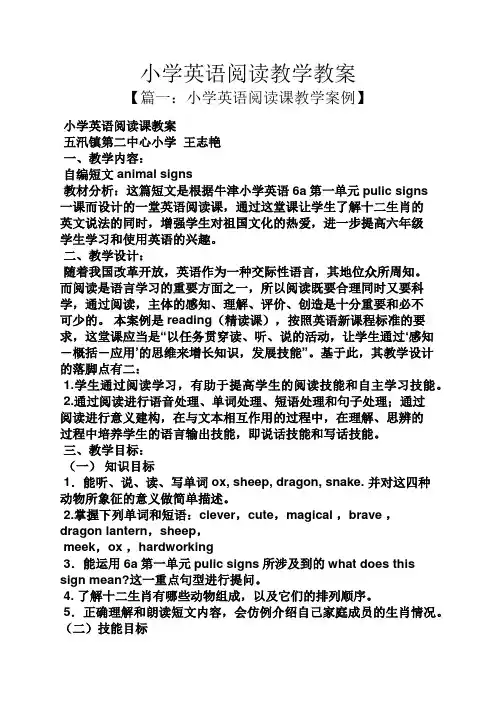
小学英语阅读教学教案【篇一:小学英语阅读课教学案例】小学英语阅读课教案五汛镇第二中心小学王志艳一、教学内容:自编短文 animal signs教材分析:这篇短文是根据牛津小学英语6a第一单元pulic signs一课而设计的一堂英语阅读课,通过这堂课让学生了解十二生肖的英文说法的同时,增强学生对祖国文化的热爱,进一步提高六年级学生学习和使用英语的兴趣。
二、教学设计:随着我国改革开放,英语作为一种交际性语言,其地位众所周知。
而阅读是语言学习的重要方面之一,所以阅读既要合理同时又要科学,通过阅读,主体的感知、理解、评价、创造是十分重要和必不可少的。
本案例是reading(精读课),按照英语新课程标准的要求,这堂课应当是“以任务贯穿读、听、说的活动,让学生通过‘感知-概括-应用’的思维来增长知识,发展技能”。
基于此,其教学设计的落脚点有二:1.学生通过阅读学习,有助于提高学生的阅读技能和自主学习技能。
2.通过阅读进行语音处理、单词处理、短语处理和句子处理;通过阅读进行意义建构,在与文本相互作用的过程中,在理解、思辨的过程中培养学生的语言输出技能,即说话技能和写话技能。
三、教学目标:(一)知识目标1.能听、说、读、写单词ox, sheep, dragon, snake. 并对这四种动物所象征的意义做简单描述。
2.掌握下列单词和短语:clever,cute,magical ,brave ,dragon lantern,sheep,meek,ox ,hardworking3.能运用6a第一单元pulic signs所涉及到的what does thissign mean?这一重点句型进行提问。
4. 了解十二生肖有哪些动物组成,以及它们的排列顺序。
5.正确理解和朗读短文内容,会仿例介绍自己家庭成员的生肖情况。
(二)技能目标1. 能初步掌握在短文中划找信息和新知的阅读方法。
2. 能就短文内容进行复述。
(三)情感目标了解及认识我国的生肖,加强对祖国传统文化的理解和热爱。
初中英语阅读课教学设计(精选6篇)
初中英语阅读课教学设计(精选6篇)初中英语阅读课教学设计(精选6篇)作为一名优秀的教育工作者,就不得不需要编写教学设计,教学设计是实现教学目标的计划性和决策性活动。
那么大家知道规范的教学设计是怎么写的吗?下面是小编为大家收集的初中英语阅读课教学设计(精选6篇),希望对大家有所帮助。
初中英语阅读课教学设计1一、教学工具:多媒体,录音机,小奖品二、教学目标:1.知识目标:1)学习give, letter, sorry, like, tall, will, young, man, woman, snowman.2)能灵活使用重点短语:give…to…, look like3)能运用下列句型谈论人物相貌:what does he/she look like?she is tall like you.2.能力目标:1)通过教学活动,培养学生的听、说、读、写的能力,尤其通过“听”和“说”,培养学生的英语语言运用能力。
2)通过所设计的课堂活动,让学生主动参与,在合作探究中学会学习和交际。
3.情感目标:1)通过教学,了解颜色及相貌在中英文中的区别,了解文化差异,提高学习兴趣。
2)通过竞赛、小组合作学习等形式,调动学生的学习主动性和积极性。
三、教学重难点:1.教学重点:1)学会运用生词和句型描述人物相貌;2)掌握have/has的否定形式;3)通过多种形式培养学生的口语交际能力。
2.教学难点:1)have/has的否定形式的教学;2)上课如何调动学生积极性。
四、教学过程step 1 warm up:enjoy a songreview the words about colors.t: we enjoyed a song just now. we have learned some words about color in section a. now please answer my questions.1) what color is it?2) how do you spell it?step 2 presentation1.lead in 3.talk about the colors of some national flags. finish 3.t: what color is the national flag?where is he/she from?what color is his/her hair?what color are his/her eyes?t: do pair works. then ask some pairs to act it out.2. lead in 2.teach “what does he/she look like?”(show another two pictures of women)(teach new words and phrases: look like, tall, man, woman, young.)t: what does the woman look like?ss: she is young. she has short blond hair and a small nose.t: what does the man look like?ss: he is old. he doesn?t have gray hair. his hair is black.(show the four pictures in part 2.)t: turn to page 35, look part 2. match the descriptions with the pictures.(ss match them)t: let?s check the answers.t: do pair works, ask and answer according to the four pictures.3. pair work: talk about the pictures, finish 2.step 3 look, listen and say1.(拿出事先准备好的一个学生的书。
初中生_英语阅读教案
教案:初中生英语阅读课一、教学目标:1. 提高学生的英语阅读理解能力,使他们能够理解文章的主旨和细节信息。
2. 培养学生的阅读策略,如预测、扫描、略读和细读等。
3. 提高学生的词汇量和语法知识。
4. 培养学生的批判性思维和合作能力。
二、教学内容:1. 文章主题:动物保护2. 关键词汇:endangered species, protection, habitat destruction,illegal hunting3. 语法点:现在进行时态和一般现在时态三、教学步骤:1. 导入:教师展示一些濒危动物的图片,引导学生谈论动物保护的重要性。
2. 阅读理解:教师发放文章,学生自主阅读,回答相关问题。
教师引导学生运用预测、扫描、略读和细读等阅读策略,提高他们的阅读理解能力。
3. 词汇和语法:教师指出文章中的关键词汇和语法点,如现在进行时态和一般现在时态,并进行讲解和练习。
4. 小组讨论:学生分成小组,讨论文章中提到的动物保护问题,并提出解决方案。
教师引导学生运用批判性思维和合作能力。
5. 总结:教师让学生总结文章的主要内容和所学的阅读策略,并强调动物保护的重要性。
四、教学评价:1. 学生阅读理解能力的提高,通过文章回答问题和课堂讨论的表现来评估。
2. 学生词汇量和语法知识的提高,通过词汇和语法练习的正确率来评估。
3. 学生批判性思维和合作能力的提高,通过小组讨论的表现和提出的解决方案来评估。
五、教学资源:1. 文章:关于动物保护的英文文章。
2. 图片:濒危动物的图片。
3. 词汇和语法练习:相关的练习题。
六、教学时间:1课时(40分钟)七、教学建议:1. 在课堂上鼓励学生积极参与,提高他们的自信心和兴趣。
2. 针对不同学生的水平,可以适当调整教学内容和难度。
3. 鼓励学生在课后进行自主阅读,扩大词汇量和提高阅读能力。
4. 注重培养学生的批判性思维和合作能力,提高他们的综合素养。
英语阅读课说课稿
英语阅读课说课稿(经典版)编制人:__________________审核人:__________________审批人:__________________编制单位:__________________编制时间:____年____月____日序言下载提示:该文档是本店铺精心编制而成的,希望大家下载后,能够帮助大家解决实际问题。
文档下载后可定制修改,请根据实际需要进行调整和使用,谢谢!并且,本店铺为大家提供各种类型的经典范文,如总结报告、合同协议、应急预案、规章制度、条据文书、心得体会、文案大全、教学资料、作文大全、其他范文等等,想了解不同范文格式和写法,敬请关注!Download tips: This document is carefully compiled by this editor. I hope that after you download it, it can help you solve practical problems. The document can be customized and modified after downloading, please adjust and use it according to actual needs, thank you!Moreover, our store provides various types of classic sample essays, such as summary reports, contract agreements, emergency plans, rules and regulations, documentary evidence, insights, copywriting guides, teaching materials, essay guides, and other sample essays. If you would like to learn about different sample formats and writing methods, please stay tuned!英语阅读课说课稿英语阅读课说课稿(通用8篇)作为一名无私奉献的老师,通常需要用到说课稿来辅助教学,说课稿有助于提高教师理论素养和驾驭教材的能力。
英语阅读课的教学设计
英语阅读课的教学设计 英语阅读课⽂具有题材⼴泛、体裁各样、语⾔知识丰富等特征,是各单元教学的核⼼部分,也是培养学⽣阅读能⼒的主要渠道。
下⾯店铺给⼤家提供了⼀节英语阅读课的教学设计,有需要的朋友可以阅读参考⼀下哦! 【⼀节英语阅读课的教学设计】 教学⽬标 1. 语⾔知识⽬标: a) 学习掌握与地震相关的词汇和短语,并掌握复杂数字的表达法。
2. 语⾔技能⽬标: a)阅读技能的训练:让学⽣学会克服⽣词障碍,通过略读,归纳出⽂章的⼤意;通过细读,理清⽂章的总体框架与脉络,归纳出各部分的中⼼词;通过查读,捕捉⽂章的重要细节,培养学⽣获取、处理信息的能⼒。
b) 让学⽣复述课⽂,分析、感悟作者的写作意图。
c) 让学⽣运⽤本节课所学词汇、知识,通过采访唐⼭⼤地震幸存者的形式进⾏⼩组活动,提⾼学⽣⽤英语进⾏创造性交流的能⼒。
3.情感态度与⽂化意识⽬标: a)学会有关地震的知识,并能通过学习讨论懂得地震时的应急逃⽣,地震后如何科学救⼈和有关地震的形成和减少地震所造成的损失等⼀般知识。
b)懂得地震⽆情⼈有情,即使发⽣了多么可怕的灾难,国家和解放军官兵都会不顾⾃⾝安危,奋⼒抢救,培养学⽣⼀⽅有难、⼋⽅⽀援的互助友爱精神。
c)了解⾃然灾害会给⼈类带来严重的破坏性后果,让学⽣进⼀步感悟、领会到⼈类应与⾃然界和谐共处。
d)培养学⽣的合作意识和“合作学习”的习惯。
e)欣赏课⽂中优美句⼦,了解⼀些英语修辞⼿法,使学⽣在学习完课⽂之后得到⼀次美的享受,⼀次⼼灵的愉悦和升华。
教学过程: 步骤⼀. Pre-reading activities 采⽤直观教学法,引⼊话题,激发学习兴趣,明确学习任务。
设计思路:先播放有关05年巴基斯坦地震的可怕MTV画⾯,学⽣的注意⼒马上就会被吸引到课堂上来,学⽣马上就联想到earthquake这⼀词,这时教师提出“ What do you think of the earthquake?”,学⽣会不约⽽同地回答,地震会给⼈类带来灾难性的后果。
- 1、下载文档前请自行甄别文档内容的完整性,平台不提供额外的编辑、内容补充、找答案等附加服务。
- 2、"仅部分预览"的文档,不可在线预览部分如存在完整性等问题,可反馈申请退款(可完整预览的文档不适用该条件!)。
- 3、如文档侵犯您的权益,请联系客服反馈,我们会尽快为您处理(人工客服工作时间:9:00-18:30)。
英语阅读课教学设计
滨海县大套中学水克祥
一、教材依据
本课时选择的是《牛津初中英语》七年级上Unit4 Food,主要围绕本单元中心任务“ Food and lifestyles”而展开的。
这篇文章主要讲述了Kitty 和Daniel 过去和现在的饮食和生活习惯,通过比较,让学生明白什么是健康饮食和生活习惯。
二、教学原则与理念
1 实行课堂教学任务化,任务生活化,评价方式过程化,以学生为主体,以话题为主
线,以任务为中心。
2 教学设计突出学生的主体地位,尊重学生个体差异。
3 灵活使用、整合教学资源,优化教学效果。
三、教学目标
1. 知识目标:
(1)词汇:扩展有关食物和生活方式的词汇
(2)日常交际用语: 1. What is your favorite food?
2. I like/dislike ……
2. 能力目标
(1)根据图片猜测大意
(2)掌握模仿主题进行描述的技巧,练习了解文章大意,快速浏览查找细节的快速阅读技巧
3. 情感目标
创造机会,鼓励学生用所学的英语知识合作交流,共同完成任务,使他们体验成功,激发学习英语兴趣。
4. 德育目标
通过本文学习增强学生健康意识,使他们明白生活中不能挑食,要珍惜粮食,养成优良的生活方式。
四、教学重点掌握文章中的词汇和理解课文内容,掌握阅读的技巧。
五、教学难点
明白健康饮食和优良生活习惯的重要性
六、教学准备
1. 教师:挂图、录音机、小黑板、实物(水果、素菜、饮料……)
2. 学生:课前词汇预习;健康食物、生活习惯资料收集笔录。
七、教学过程:
Step 1: Warming - up (热身)
(一)Free Talk: To ask the student on duty to make a speech : “Whats my
favourite food ? ”
设计思路:每天都有值日生报告,可以锻炼学生的书写和口头表达能力,另外,在交流过程中,也互相锻炼了学生的听力水平。
同时,活跃了课堂气氛。
(二) 1. Revise some names of food (Let the students speak freely.)
2. To show the students beautiful pictures of food during the talking .The teacher can
write some of them on the blackboard, especially some new words: fruit, sweet, coke,
bread, meat, juice.
3. To ask the students to ask and answer : “What is it ? ”, “Do you like
it ? ” ,then discuss: “(1)What food can we? e a(t2a) Wlothich is
your favorite food? Why?
设计思路:
( 1)让学生自由回答,复习已学了的食物名称,满足学生表现的欲望,进一步活跃课堂气氛,调动学生积极性。
(2)通过形象直观图片教学,激活旧知识,为学习新知识做铺垫。
(3)通过有趣的话题极大地激发学生的好奇心,为进入正文教学打下基础。
让他们参与
初步讨论,知道哪些才是正确的饮食。
Step 2: Pre-listening( 听读)
1. First, let the students look at the photos on Page 60.
2. Second, listen to the tape and read the articles about Kitty and Daniel and tell the
teacher who is healthy.
设计思路:
听和读都是获取信息的有效途径,通过边听边读(默读)初步感知文
章内容培养学生快速概括文章主题能力
Step 3: Skimming and Note-taking(速读和速记)
1. What does Kitty want to be?
2. What does Kitty eat for breakfast now ?
3. What does Daniel like eating?
4. What does Daniel plan to do?
设计思路:通过有目的听读,让学生了解文章大意同时把握文章中一些细
节内容培养学生阅读技巧,通过有目的地快速浏览文章,解决一些文章中
较简单直观的题目。
Step 4: Seanning(审读)
Read the text again; try to answer the questions below:
1. How long does kitty danee every day?
2. How does she feel when she danees?
3. What is important for her?
4. What does she have for dinner?
5. What does Daniel like doing?
6. Does Daniel have a healthy diet or lifestyle? Why?
7. Can he run fast? Why?
8. What does he plan to do?
设计思路:进一步有目的的阅读,可以更好的理解文章细节,培养学生做
细节题目的能力,同时以竞赛的形式进行能更进一步激发学生地主动参
与。
Step5:Explaining main and diffieult points (释疑)
Let the students work in groups and find out the diffieult points, then tell the teaeher.
设计思路:在限定时间内划出疑难问题,在组内讨论,互相启发,教师巡查,给学生提供及时帮助,然后小组向全班陈述本组难题,教师根据各组信息反馈,通过典型例句精讲重难点,培养学生独立思考问题、解决问题的能力和合作探究精神。
Step6: Communieation and Applieation(交流与应用)
1. To ask the students to retell the story
2. The teacher give them a topic: “ how to keep healthy ”
设计思路:
1. 复述文章有助于培养学生语言运用能力,同时锻炼学生听说能力
2. 学以致用,话题贴近生活,可以对学习英语产生更大的兴趣,同时,通过这项活动可以充分训练学生英语综合技能。
Step7:Summary and Check-up(归纳与总结)
1. T:What have you learned from this class? What should you do?
2. Ma in poi nts(略)
Step8:Homework(作业)
1. 思考:What food is (not) healthy?归类)
2. 写作:How to keep healthy?
3. 查找:1)vitamin 类型及其作用(Internet)
2)采访父母亲戚怎么样保持健康
设计思路:
1. 布置总结归类性作业需要学生通过交流、辨别找出它们的共同点和不同点,锻炼了学
生辨别是非的能力。
2. 把课堂上讨论交流的话题总结整理成文章,可以全面检测教学效果,同时也是课堂教
学的延伸。
3. 采访类性作业需要学生查资料(充分利用好农村刚建设好的“ 校校通工程”,丰富
学生的知识面,增强学生查找、整合、利用资料的能力),与他人合作交流,使学
生将所学英语知识用于实践,达到在用中学,学了就用的目的。
八、教学反思本设计的亮点:以灵活的形式开展教学活动,以培养学生阅读技巧为中心。
学生反应积极,讨论热烈,思维活跃,竞争激烈,教学效果令人满意,同时过程也合理安排了合作探究活动,让学生共同提高。
通过阅读让学生理解课文内容,形成阅读技能,主要通过“快速浏览、提炼大意、细节捕捉、交流应用” 四个步骤,培养学生概括主题,捕捉细节和再现阅读内容的技能。
教师能注意设计合适的衔接语言,使整个环节过渡自然,让学生轻松学好每节课
教师应该更多关注如何使学生掌握阅读技巧,而不是仅向学生灌输大量的语言知识。
教学过程是学生在教师的帮助和指导下掌握知识和形成技能的过程。
活动中发挥学生主体地位,让学生自己去发现问题、分析问题和解决问题。
在教学设计中,我们要考虑学生情感的重要性,要设法让学生在欢乐的情景下学习,但教师不能一味追求所谓“快乐”,忽略了学生对知识的掌握
和能力的培养。
设计了相应地评价模式,根据小组自学程度、参与度、合作成果、作业情况等项目制定了一张表格,把每天课内外优胜小组记录下来,一单元结束后进行总评价、表彰,在课堂上也给予学生相应口头评价,把形成性评价和终结性评价相结合,让学生能进步更快,学得更快乐。
